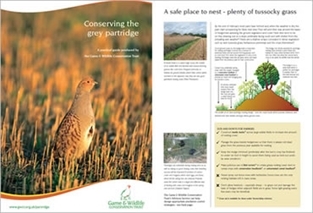Key findings
- Densities of grey partridges were highest in small fields and those with tussocky grass margins.
- Partridge breeding pair densities were negatively associated with woodland.
- Of all crop types, productivity appeared highest in dried (combinable) peas.
Norfolk has been a stronghold for grey partridges in Britain. A long history of gamekeeping, light soils and diverse cropping provide favourable conditions for them. In common with the rest of Britain, numbers have declined in recent decades, although many farms and estates are now working to restore them on their land. On one famous shooting estate in north Norfolk, partridge numbers on a study area of 4,000 hectares comprising five different game beats have been monitored for many years.
Each spring, breeding pairs are located and marked on maps (see Figure 1). In autumn, after harvest, the locations of all coveys are recorded along with the sex and age of the birds. Crop type and the locations of hedges, game covers, grass margins and beetle banks are also recorded. We were interested to find out how cropping patterns and permanent habitat features influenced the distribution and productivity of partridges on this estate. To do this we used a Geographic Information System to analyse spatial patterns in the distribution of partridge pairs and coveys in relation to crop type and proximity to linear habitat features using data collected over a seven-year period.
Figure 1: Grey partridge pairs on one game beat (600 hectares) on a Norfolk partridge estate in 2006

Spring pairs were positively correlated with the proportion of permanent boundary features in the landscape (see Figure 2). In other words, partridges preferred to set up breeding territories in smaller fields alongside hedges with grass margins or along beetle banks, or were there were strips of semi-permanent perennial game cover like chicory. As well as providing potential nesting cover, these areas provide escape cover from raptors, especially sparrowhawks. These are also the areas where feed hoppers are located, which is likely to influence the distribution of partridge territories.
Crop type was not particularly important in influencing where pairs set up their territories, although there was a tendency for them to avoid spring-sown crops, presumably because they offer less cover at count time than autumn-sown ones. Farmyards and gardens were also positively correlated with spring pairs, probably because of the availability of cover and food. There was a negative correlation between the amount of woodland cover and partridge density, which is not surprising as partridges are known to favour open habitats.
Based on autumn counts, the productivity of partridges is measured by the chick survival rate (CSR) and the brood production rate (BPR). Higher BPRs were associated with fields of combinable peas. Anecdotally, dried peas have often been cited as being good for partridges. They are not harvested until quite late, allowing broods to get away, and they are usually rich in insects, particularly the large pea aphid. Densities of partridges on pea stubbles are likely also to be influenced by the quantity of highly nutritious spilt peas left after harvest.
No other combinable crops were positively correlated with CSR or BPR. However, a number of ‘crop types’ were negatively correlated with CSR or BPR including fields under organic conversion, set-aside/fallow land, grassland and woodland. Fields under organic conversion are subject to a cutting regime through the partridge breeding season, hence it is possible that nests and broods may be lost in this crop. The effect of organic cropping after the organic conversion will be analysed in future years. The results of this study suggest that by providing more hedges and narrow strips of vegetation that provide cover in late winter and early spring, the farmed landscape will be more attractive to partridges when they are forming breeding pairs. Fortunately, these habitats can be provided within agri-environment stewardship schemes.
Figure 2: The relationship between grey partridge pair density and the proportion of linear features (hedgerows, grass margins and beetle banks) in the landscape

Each point on the graph represents average data from areas of high, medium and low partridge density in each year between 2000 and 2006 on one partridge beat.
Get your FREE Grey Partridge Conservation Guide
An essential guide to conserving the grey partridge produced by the Game & Wildlife Conservation Trust.
What's inside your FREE guide
✓ The decline of a common farmland bird
✓ A safe place to nest - plenty of tussocky grass
✓ Chick survival - insect food is crucial
✓ Surviving winter and spring - food and cover
✓ Conservation targets - Partridge Count Scheme
✓ Grey partridges and shooting
✓ Common questions
Download guide now >